You need to upgrade your Flash Player
Please visit Adobe's Flash Player site to upgrade the most recent version.
Thank you.
If you are having issues with installing Adobe Flash Player, please make sure that all "pop-up killer" applications are turned off and you reinstall
the Adobe player.
Chania - Crete
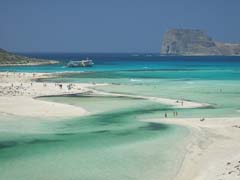
About Chania prefecture
general information
- Chania is a prefecture in Crete island
- Area: 2,380 square km
- Population is approximately 156,800 inhabitants
- Capital of Chania is Chania Town
- Main port is in Chania Town
- Connected with Piraeus port of Athens
- Connected via ferry with some Cycladic islands
- Connected with Athens Athens International Airport

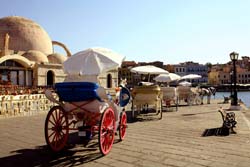 GEOGRAPHY
GEOGRAPHYLocated on the west coast of Crete, the prefecture of Chania is the most mountainous area of Crete and is dwarfed by the imposing mass of the White Mountains, about 40 km long. The tallest peak (Pachnes, 2453m) has snow up to and including the month of May! There are four mountain shelters (Kallegris, Tavri, Svourichti, Volikas). The south side of the island, facing the Lybian sea, has the longest sunny days in Europe. North, west and south, the country is surrounded by sea.
The northern side of Chania, which has very hospitable seas, ends in three peninsulas. Tourist development here is intense, so of course this side is more populated. Here you will find excellent, modern, well equipped hotels with willing and friendly personnel. The country is 2,376 km2 big and has a population of 140,000. It is divided into five districts, with the town of Chania as its capital pop.52,000). Over 500 villages arrayed on the sides of the mountains on the mountain plains of Omalos and Sfakia, but mostly near the sea are waiting for you. A short way out of Georgioupoli (east of Chania) you will find the unrivalled Cretan lake of Kournas.
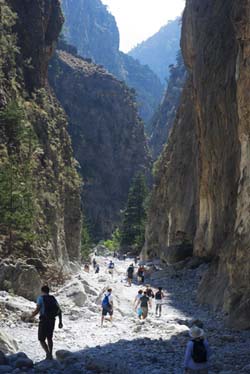 CLIMATE
CLIMATE There is usually a mild Mediterranean climate. In autumn and winter the winds are usually North/Northwest while in the summer, light breezes make it enjoyable. However, God’s gift of unending sunshine allows you to start your holiday form the month of March and finish at the end of October. The country of Chania has the most spring water in Crete (65%). This is why there is so much vegetation and fruit bearing trees (citrus, olive, grape, etc), which flourish year after year. The sparkling clear seas of Chania, which always win the European “Blue Flags” are accessible for all ages, all year around.
FLORA AND FAUNA
The climate and the configuration of the land make the county of Chania a paradise for thousands of plants and animals: The lilys of the sea (pancratium maritimum), the lavdano (lavdanum), the cyclamen (cyclamen creticum), the Cretan tulips (tulipa cretica), the maple (acer creticus) and chiefly the endemic and unique dittany (origanum dictamum) and malorita (dideritis cretica), which, with matzourana (origanum maiorana), compose medicinal boiling plants of Omalos you can find stamnagathi (cihorium spinosum).
Dried or freshly cut, these special medicinal herbs can be found in the Public Market or local shops. In Crete you can find 17 unique plants, 4 of which exist only in the county of Chania.
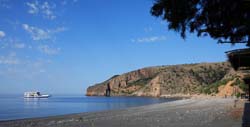 The proud Creta beast, the "Kri-Kri" (capra aegagrus cretica), lives freely only in the Samaria Gorge.
The proud Creta beast, the "Kri-Kri" (capra aegagrus cretica), lives freely only in the Samaria Gorge. There and elsewhere you can see Cretan eagles (aquila chrysaetos) and partridges (alectoris chucar). Ferrets (martes foina bunites), skunks (meles meles arcalus), weasels (mustela nivalis galinthias), hares, hawks etc. can also be seen in open places.
There is also an endeavour to protect an area on the north shores of the county especially for the turtles (caretta-caretta), that live there.
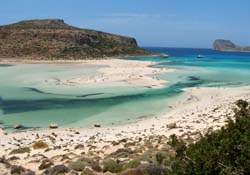 POPULAR ART
POPULAR ART Popular traditional Cretan art is continued today in weaving, crocheting, carpet making, towels, lace work etc. showing the feel for beauty and art the people of the county have. Village women and local co-operatives make embroideries from silk or wool. Hand-crafted items of glass, wood and metal can be found in Casteli Kissamos, while workshops for ceramic goods, wooden sculptures, as well as metallurgy (copper, gold and silver) are plentiful in the county.
There is a special workshop for glass blowing at Kokkino Chorio Apokoronou. Many shops selling popular art can be found in the old town. Above the Catholic Church there is the “Cretan House” (private folk museum). Rich folk material can also be found in exhibitions at the firka Fortress. You can also see collections of objects from farming and the local civilization at Kandanos, Gavalochori, Vamos, Kefalas, Therisso, Spilia Kissamos, Sougia, Askifou (Sfakia), Azogires and elsewhere. A special techniwue is the production of Cretan boots (made from genuine leather) at Stivanadika (Skridlof str., Chania) where dominating all else , is the smell of leather. Other characteristic items are Cretan Knives with four line poems written on their blades.
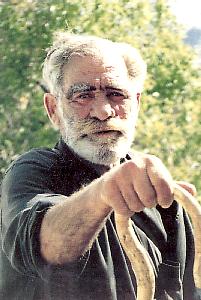 CRETANS AND THEIR WAY OF LIFE
CRETANS AND THEIR WAY OF LIFE They say the at the soul of the Chania people-and of every Cretan-is as one: haughty and proud, “straight” and hard like the steel of the their “rebels” weapons, but also mild and gentle like their love, passionate writers of verse which shows their love of their way of life.
It’s not by chance that Crete has given birth to some of the greatest men of contemporary Greece: Nikos Kazantzakis (a man of words), Eleftherios Venizelos (the great politician), Vitsentzos Kornaros (poet of tender love songs), Mikis Theodorakis (composer of passionate, stirring and expressive folk music) and Manos Hatzidakis (musician). For the people of Chania, life is a "celebration" and celebrations are opportunities to communicate. There is no town or village without a saint to protect it.
Religious celebrations and festivals are always accompanied by good food, music (Lyre) and dance. Then is your chance to try xerotigana (sweet), tsikoudia (drink), kalitsounia (cheese pies), local honey, greek soft cheese and the famous pilafi (rice with boiled meat).
CRETAN DIET
Cretan soil and its products were matched with the mythology and the ancient gods.
The purity, the richness, in vitamins and the divine taste of these products made them a quality reference for those interested in healthy nutrition and a subject of research for the scientific community, while their beneficial attributes for the prevention of carcinogenesis have already been proved.
The land, the climate, the care in cultivation the mostly the love for quality and the respect for tradition are the reasons for which Cretan goods enjoy worldwide respect. Besides, in Crete there is a rich variety of unique products, such as the Cretan olive oil, various herbs (dittany, malorita, matzourana, sage, etc. and wild plants.
These compose a superb nutritious chain, which functions as a special shield against old and contemporary diseases.

